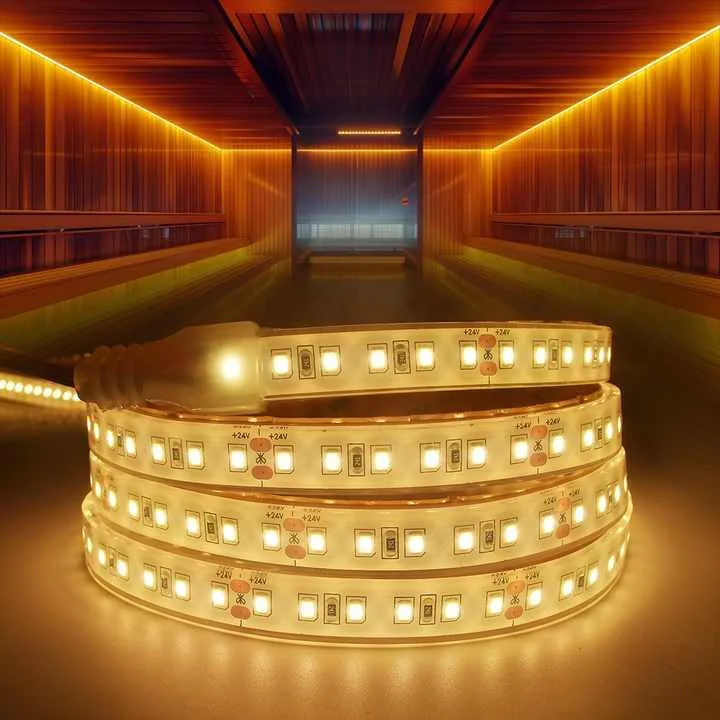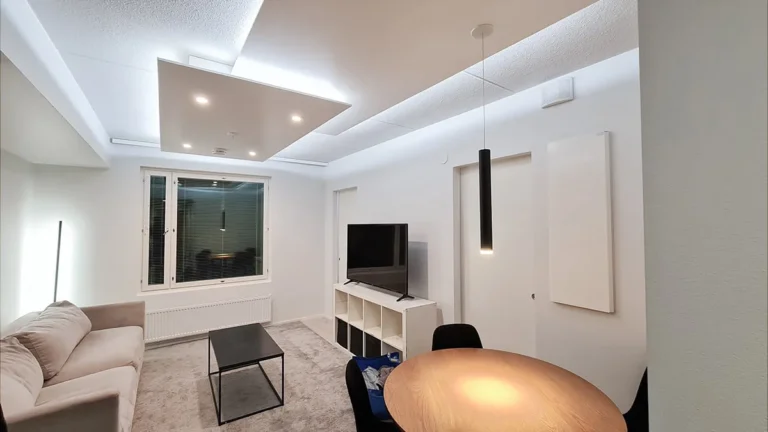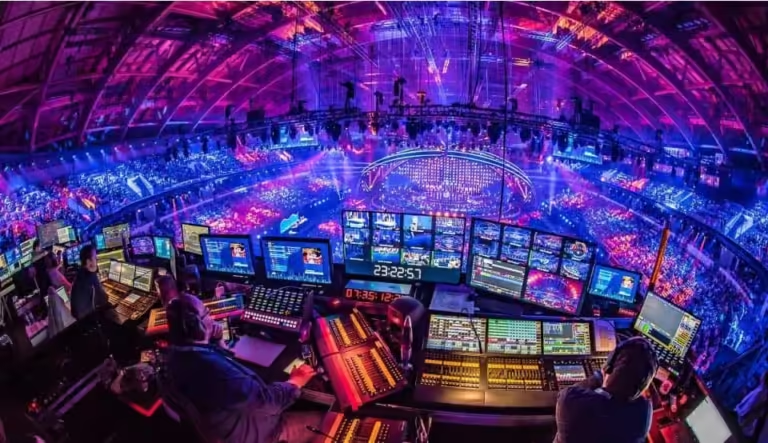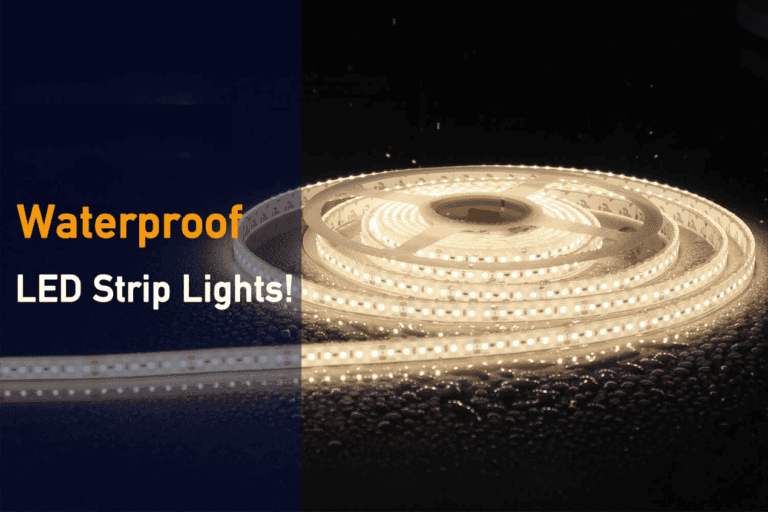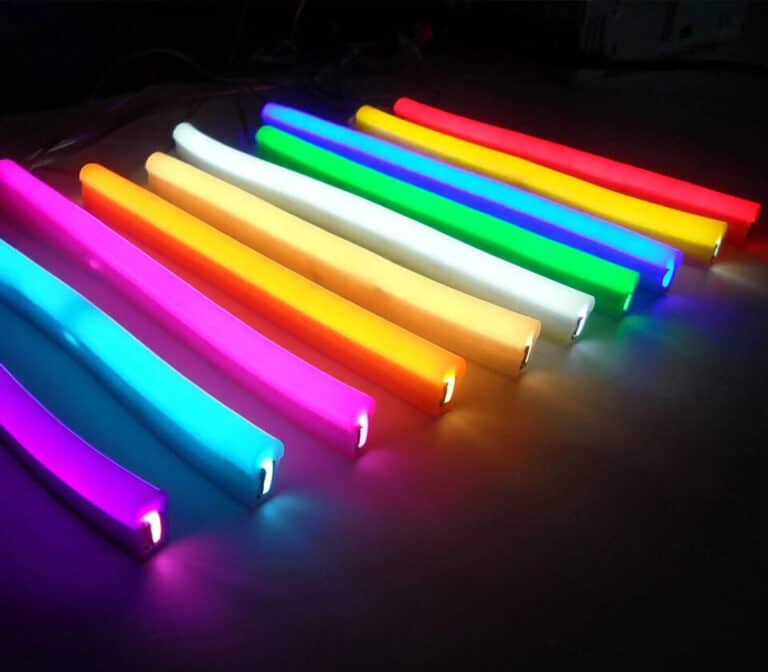LED 네온 조명은 유연성과 생생한 시각적 영향으로 인해 건축 조명, 상업 장식 및 간판 프로젝트에 널리 사용됩니다. 그러나 네온의 실제 치수가 명목상의 사양과 크게 다를 경우 심각한 설치 문제를 야기할 수 있습니다. 이 문제는 클라이언트가 지정된 차원을 기준으로 엄격하게 설치 슬롯을 준비하는 프로젝트에서 더욱 중요해집니다. 몇 밀리미터의 불일치로 인해 피팅이 좋지 않거나 간격이 잘 보이거나 구조적 비호환성이 발생할 수 있습니다. 이러한 이유로 압출 공정에 내재된 치수 변화인 압출 공차는 전문 LED 네온 응용 분야에서 제품 일관성과 원활한 설치를 보장하는 데 중요한 역할을 합니다.
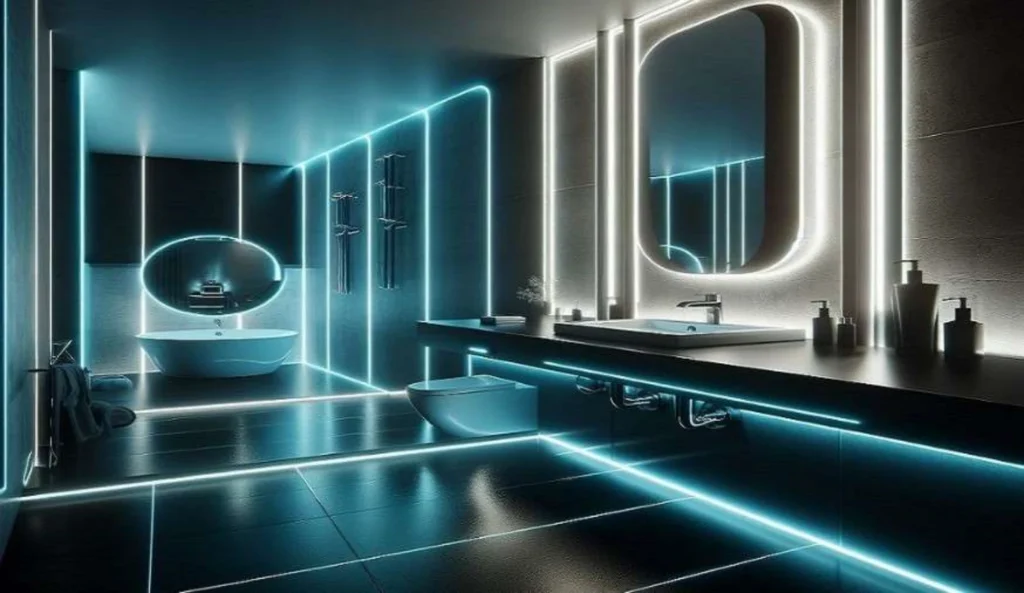
LED 네온 조명에 치수 공차가 있는 이유는 무엇입니까?
재료 속성
치수 공차에 영향을 미치는 가장 근본적인 요소 LED 네온 조명 원료입니다. 유연한 네온 프로파일은 일반적으로 실리콘 또는 PVC로 만들어지며 둘 다 열팽창 및 수축의 대상이 됩니다. 생산 중 또는 나중에 적용되는 동안 약간의 온도 변화가 있어도 압출의 폭, 높이 또는 곡률에 변화가 있을 수 있습니다. 배치 간의 재료 경도 또는 배합의 차이는 치수가 일치하지 않아 재료 안정성이 공차 제어에서 중요한 요소가 될 수 있습니다.
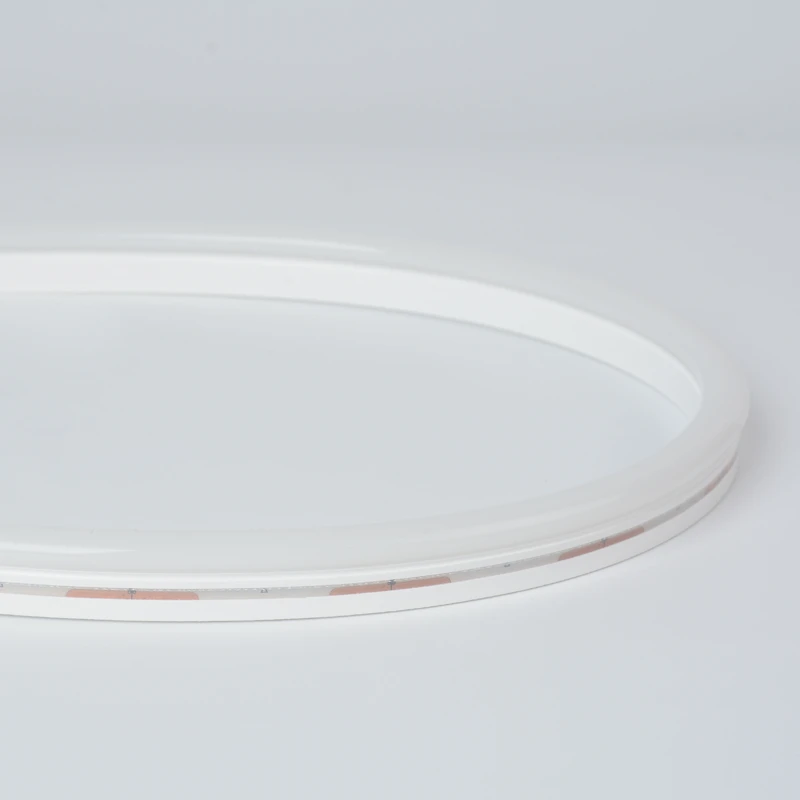
실리콘 네온 라이트
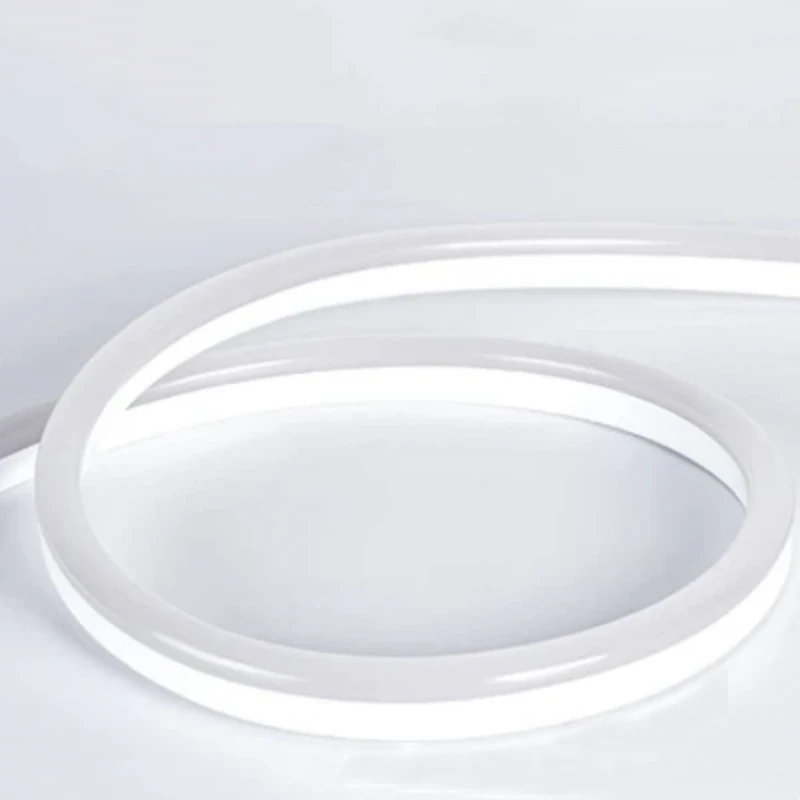
PVC 네온 라이트
압출 공정 제어
압출 과정 자체는 치수 변화의 또 다른 주요 원인입니다. 정밀도는 압출 금형의 정확도와 온도, 압력 및 압출 속도의 일관성에 크게 의존합니다. 예를 들어, 냉각 조건이 불안정한 경우(예: 수냉식 또는 공기 흐름이 일치하지 않는 경우) 프로파일이 수축되거나 변형되지 않을 수 있습니다. 이러한 작은 편차가 누적되어 최종 제품이 지정된 허용 범위를 벗어날 수 있습니다.
생산 배치 변동성
동일한 금형과 재료를 사용하더라도 치수 공차는 생산 배치마다 다를 수 있습니다. 기계 보정, 작업자 조정 및 습도와 같은 환경 조건과 같은 요소가 결과에 미묘하게 영향을 미칠 수 있습니다. 대량 생산량에 걸쳐 이러한 변형은 LED NEON과 장착 채널 및 액세서리의 호환성에 직접적인 영향을 미칠 수 있습니다.
가격 및 비용 압박
종종 간과되는 또 다른 요소는 가격 책정입니다. 경쟁이 치열한 시장에서 일부 저비용 공급업체는 재료 품질을 타협하거나 비용 절감을 위한 생산 단계를 줄일 수 있습니다. 더 저렴한 실리콘, 재활용 PVC 또는 덜 정확한 압출 장비를 사용하면 불가피하게 치수 변화가 증가합니다. 선행 가격은 매력적일 수 있지만, 부적합한 피팅, 수명 단축 및 유지 관리 비용의 높은 유지 비용의 장기적인 위험으로 인해 이러한 타협은 전문 프로젝트에 비용이 많이 듭니다.
LED 네온 압출을 위한 공차 범위
산업 공차 기준
LED 네온 산업에서 압출 내성은 일반적으로 신뢰할 수 있는 피팅과 균일한 외관을 보장하기 위해 작은 여백 내에서 정의됩니다. 대부분의 제조업체는 프로파일의 크기와 모양에 따라 ±0.3mm에서 ±1.0mm 사이의 치수 공차를 채택합니다. 단일 글로벌 표준은 없지만 이러한 범위는 일반적으로 건축 및 사이니지 응용 분야의 전문 프로젝트에서 허용됩니다.
발광 유형의 차이
공차 요구 사항은 또한 배출 구조에 따라 다를 수 있습니다. 전면 방출 네온은 가시적인 표면이 조명 균일성에 직접적인 영향을 미치기 때문에 더 엄격한 제어를 제공하는 반면 측면 방출 네온 및 상단 벤딩 유형은 구조적 유연성으로 인해 약간 더 넓은 허용 오차를 허용합니다. 270° 또는 360° 방출 네온과 같은 더 큰 커버리지 프로파일은 치수 이동이 배광과 설치 안정성 모두에 영향을 미치기 때문에 압출 중에 더 면밀한 모니터링이 필요합니다.
네온 크기 및 유형별 일반적인 공차 범위
| LED 네온 타입 | 일반 크기 (W×H 또는 직경) | 일반적인 압출 공차 |
| 미니 네온(슬림) | 4×8mm | ±0.3mm |
| 미니 옆방형 네온 | 6×12 MM | ±0.4mm |
| 표준 전면 방출 | 8×16mm | ±0.5mm |
| 표준 측방출 | 10×20mm | ±0.5mm |
| 최고 굴곡 네온 | 12×20mm | ±0.5mm |
| 넓은 앞쪽 발광 네온 | 12×25mm | ±0.6mm |
| 270° 라운드 네온 | Ø16mm | ±0.6mm |
| 270도의 대형 네온 | Ø20mm | ±0.8mm |
| 360° 유연한 네온(소형) | Ø15mm | ±0.5mm |
| 360° 유연한 네온(대형) | Ø25mm | ±1.0mm |
치수 공차가 NEON 응용 프로그램에 미치는 영향
1. 설치 문제
LED 네온사인의 압출 공차가 잘 제어되지 않으면 설치에 문제가 생깁니다. 약간의 치수 변화라도 알루미늄 채널이나 장착 슬롯 내부에서 프로파일이 너무 조여지거나 너무 느슨해질 수 있습니다. 이것은 종종 현장 피팅 동안 눈에 보이는 간격, 고르지 않은 정렬 또는 노동 증가로 이어집니다. 대규모 건축 프로젝트의 경우 원활한 설치를 달성하고 재작업을 줄이기 위해 일관된 치수가 필수적입니다.
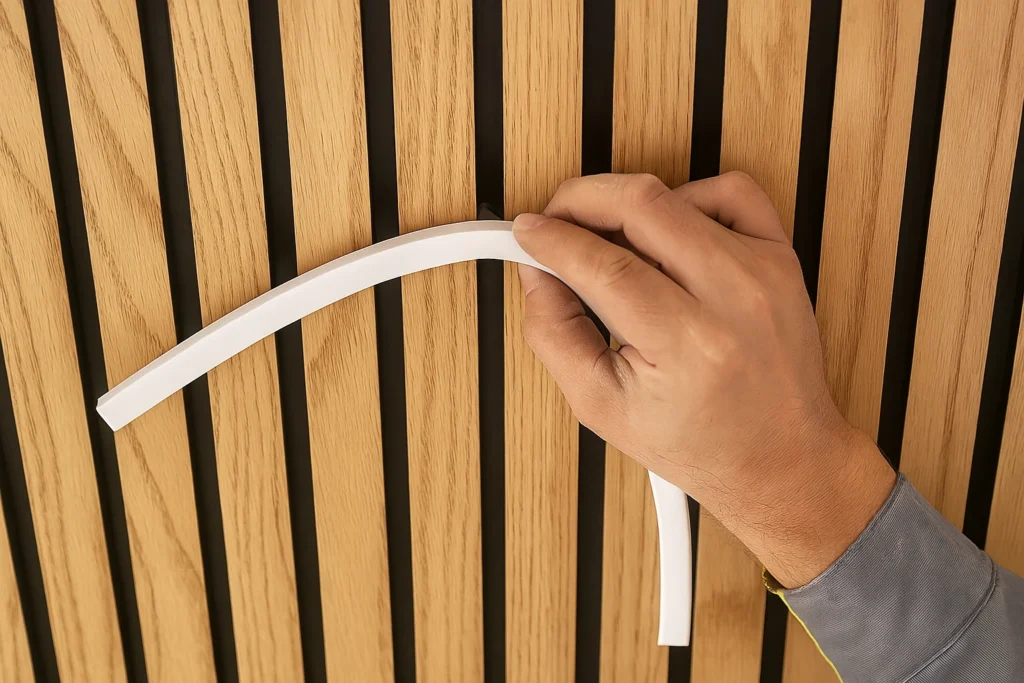
2. 가벼운 균일성에 미치는 영향
압출 공차는 또한 광 출력의 균일성에 영향을 미칩니다. 실리콘 또는 PVC 캡슐화의 두께가 변하면 일관되지 않은 확산이 발생하여 더 밝거나 어둡게 보이는 영역이 발생할 수 있습니다. 전면 발광 네온에서 이 고르지 않은 조명 분배가 특히 눈에 띄게되어 설치의 전체적인 시각적 품질이 저하됩니다.
3. 방수 등급 및 신뢰성
공차 문제는 LED 네온 제품의 방수 및 장기 신뢰성에 더욱 영향을 미칩니다. 프로파일 치수가 지정된 범위에서 벗어나면 엔드 캡, 커넥터 또는 조인트 주변의 밀봉이 완전히 효과적이지 않을 수 있습니다. 이는 IP 등급을 손상시키고 물 침투 위험을 증가시켜 제품의 수명을 단축하고 실외 응용 분야에서 고장을 일으킬 수 있습니다.
LED 네온 조명에서 허용 오차 문제를 제어하고 해결하는 방법
1. 제조 공정 최적화
압출 내성을 줄이는 첫 번째 단계는 제조 공정을 정밀하게 제어하는 것입니다. 고정밀 금형, 안정적인 압출 속도 및 적절한 온도 조절은 모두 일관된 치수를 유지하는 데 중요한 역할을 합니다. 압출 장비의 정기적인 유지 보수 및 교정은 정확성을 더욱 보장합니다.
2 품질 관리 조치
엄격한 품질 관리도 똑같이 중요합니다. 제조업체는 압출 중에 인라인 모니터링을 구현하고 완성된 LED 네온 조명에 대한 최종 차원 검사를 수행해야 합니다. 허용 오차 데이터를 사용하면 추세를 감지하고 결함이 있는 배치가 고객에게 도달하는 것을 방지하는 데 도움이 됩니다.
3. 프로젝트 설계 및 설치 고려 사항
프로젝트 관점에서 디자이너와 설치자는 슬롯 크기, 알루미늄 채널 및 액세서리의 공차 마진을 허용하여 위험을 최소화할 수 있습니다. 압출 변형을 염두에 두고 계획하면 현장 설치가 원활하고 예상치 못한 조정이 줄어듭니다.
4. 신뢰할 수 있는 공급업체 선택
마지막으로 LED 네온 압출 내성에 대한 입증된 전문 지식을 갖춘 공급업체를 선택하는 것이 중요합니다. 첨단 장비, 인증 및 강력한 품질 시스템을 갖춘 전문 제조업체는 보다 안정적인 제품을 제공하여 프로젝트 소유자가 장기적인 성과에 대한 확신을 줍니다.

결론: 전문 주도 네온 프로젝트의 일관성 보장
치수 공차는 LED 네온 라이트 제조에서 피할 수 없는 요소이지만 올바른 재료, 엄격한 압출 제어 및 전문적인 품질 관리를 통해 효과적으로 최소화할 수 있습니다. 건축가, 설계자 및 계약자에게 신뢰할 수 있는 공급업체와 협력하는 것은 원활한 설치와 장기적인 성능을 보장하는 열쇠입니다.
에서 사인라이트LED, 우리는 모든 네온 압출에 고급 흄드 실리콘을 사용하여 산업 내 허용 표준을 완전히 충족하는 안정적인 치수를 보장합니다. 프로젝트에 고유한 크기 또는 더 엄격한 공차가 필요한 경우 당사 팀은 정확한 사양에 맞는 맞춤형 솔루션을 제공할 수 있습니다. 귀하의 요구 사항에 대해 논의하고 전문적인 응용 분야에 맞게 조정된 고품질 LED 네온 조명을 확보하려면 지금 문의하십시오.

